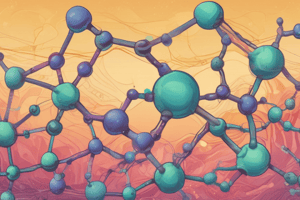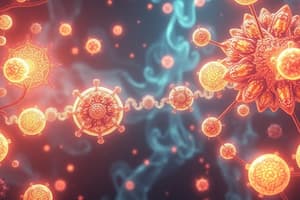Podcast
Questions and Answers
Which type of carbohydrate is primarily found in fruits?
Which type of carbohydrate is primarily found in fruits?
- Disaccharides
- Polysaccharides
- Monosaccharides (correct)
- Oligosaccharides
What are triglycerides primarily used for in living organisms?
What are triglycerides primarily used for in living organisms?
- Hormone production
- DNA synthesis
- Cellular structure
- Fuel storage (correct)
Which group of lipids is crucial for making cell membranes?
Which group of lipids is crucial for making cell membranes?
- Steroids
- Phospholipids (correct)
- Waxes
- Neutral fats
What type of bond forms between amino acids during protein synthesis?
What type of bond forms between amino acids during protein synthesis?
Which amino acid is known to be a precursor of serotonin?
Which amino acid is known to be a precursor of serotonin?
What do complex carbohydrates primarily consist of?
What do complex carbohydrates primarily consist of?
Which of the following is classified as a steroid?
Which of the following is classified as a steroid?
What is a dipeptide formed from?
What is a dipeptide formed from?
What is a critical requirement for forming organic compounds in the early Earth environment?
What is a critical requirement for forming organic compounds in the early Earth environment?
Which energy source is believed to have contributed significantly to organic synthesis on primitive Earth?
Which energy source is believed to have contributed significantly to organic synthesis on primitive Earth?
What hypothesis suggests that life began deep in the sea?
What hypothesis suggests that life began deep in the sea?
What did Miller and Urey's experiment successfully synthesize?
What did Miller and Urey's experiment successfully synthesize?
What is the general composition ratio of carbohydrates?
What is the general composition ratio of carbohydrates?
What does the term 'organic' broadly refer to in chemistry?
What does the term 'organic' broadly refer to in chemistry?
What is the primary unit that composes all living forms?
What is the primary unit that composes all living forms?
Which element is noted for its ability to bond with other atoms to create a variety of molecular structures?
Which element is noted for its ability to bond with other atoms to create a variety of molecular structures?
Which process captures sunlight and converts it into chemical energy?
Which process captures sunlight and converts it into chemical energy?
Which environmental condition is associated with the creation of organic compounds on the primitive Earth?
Which environmental condition is associated with the creation of organic compounds on the primitive Earth?
What does the second law of thermodynamics state regarding energy?
What does the second law of thermodynamics state regarding energy?
Who was the scientist that first observed cells and coined the term 'cells'?
Who was the scientist that first observed cells and coined the term 'cells'?
What significant role do specialized cells in multicellular organisms perform?
What significant role do specialized cells in multicellular organisms perform?
What is the estimated number of cells in a human body?
What is the estimated number of cells in a human body?
What characteristic is common in all living cells even if they are primitive?
What characteristic is common in all living cells even if they are primitive?
What happens to energy that supports life activities within cells?
What happens to energy that supports life activities within cells?
What is the main hypothesis proposed by Lynn Margulis regarding the origin of eukaryotes?
What is the main hypothesis proposed by Lynn Margulis regarding the origin of eukaryotes?
Which of the following statements about mitochondria and plastids is true?
Which of the following statements about mitochondria and plastids is true?
What advantage did the host cell gain from having plastids and mitochondria?
What advantage did the host cell gain from having plastids and mitochondria?
What ecological change occurred as a result of herbivores cropping plants?
What ecological change occurred as a result of herbivores cropping plants?
What factor is thought to have contributed to the evolutionary explosion at the end of the Precambrian period?
What factor is thought to have contributed to the evolutionary explosion at the end of the Precambrian period?
Which group is considered the first eukaryotes and is primarily autotrophic?
Which group is considered the first eukaryotes and is primarily autotrophic?
How did cyanobacteria contribute to the evolutionary process mentioned?
How did cyanobacteria contribute to the evolutionary process mentioned?
What characteristic is common among eukaryotic cells as opposed to prokaryotic cells?
What characteristic is common among eukaryotic cells as opposed to prokaryotic cells?
Which term describes anatomical structures that perform the same function in different species due to shared ancestry?
Which term describes anatomical structures that perform the same function in different species due to shared ancestry?
What does ontogeny refer to in biological terms?
What does ontogeny refer to in biological terms?
According to Ernst Haeckel, how does ontogeny relate to phylogeny?
According to Ernst Haeckel, how does ontogeny relate to phylogeny?
What is speciation?
What is speciation?
Which of the following is NOT a type of reproductive barrier?
Which of the following is NOT a type of reproductive barrier?
In terms of evolutionary biology, what relationship does the pentadactyl limb illustrate?
In terms of evolutionary biology, what relationship does the pentadactyl limb illustrate?
Which feature of a human embryo supports the idea of recapitulation?
Which feature of a human embryo supports the idea of recapitulation?
How does multiplication of species over time occur according to Darwin's theory?
How does multiplication of species over time occur according to Darwin's theory?
Flashcards are hidden until you start studying
Study Notes
Origins of Life
- Formation of organic compounds requires energy to overcome activation barriers from existing strong bonds.
- Ultraviolet light from the sun was intense in early Earth before atmospheric oxygen accumulation.
- Lightning and thunderstorms served as vital energy sources for organic synthesis.
- Volcanic activity likely contributed additional energy.
- Hypothesis suggests life originated near hydrothermal vents, where super-heated water transports various dissolved molecules.
- Miller and Urey's 1953 experiment synthesized amino acids from primitive Earth-like conditions using continuous electrical sparks.
Carbohydrates
- Most abundant organic substances, composed of carbon, hydrogen, and oxygen in a 1:2:1 ratio.
- Serve as structural elements and chemical energy sources in cell protoplasm.
- Types of carbohydrates:
- Simple sugars (monosaccharides: glucose, galactose, fructose)
- Double sugars (disaccharides: sucrose, maltose, lactose)
- Complex sugars (polysaccharides: starch, glycogen)
Lipids
- Function as fuel stores and building materials in organisms.
- Types of lipids include:
- Neutral fats: Major fuel source, derived from food or unconverted carbohydrates.
- Phospholipids: Key components of cell membranes, bridging water-soluble and insoluble materials.
- Steroids: Complex alcohols with fat-like properties; include cholesterol, vitamin D, and sex hormones.
Proteins
- Composed of 20 amino acids; crucial for various biological functions.
- Key amino acids include:
- Tryptophan: Precursor of serotonin
- Glycine: Precursor of porphyrins like heme
- Arginine: Precursor of nitric oxide
- Carnitine: Facilitates lipid transport within cells.
- Amino acids link via peptide bonds, forming proteins, with water as a byproduct.
Eukaryotic Evolution
- Eukaryotes possibly evolved from symbiotic relationships among different bacteria.
- Mitochondria and plastids retain distinct DNA and prokaryotic characteristics.
- Evolutionary advantages arose from photosynthetic capabilities and oxidative metabolism.
- Early eukaryotes were likely unicellular and included photosynthetic autotrophs that evolved into heterotrophs.
Ecosystem Development
- The evolution of carnivores and herbivores led to a balanced ecosystem.
- Herbivores' consumption encouraged diversity among plant producers and specialization in the food pyramid.
- An explosion of evolutionary activity marked the end of the Precambrian and the beginning of the Cambrian due to increased atmospheric oxygen, supporting larger multicellular organisms.
Cell Theory
- All living organisms are composed of cells; new cells arise from existing ones.
- Energy for cellular processes primarily comes from sunlight via photosynthesis.
- Energy is utilized for various functions and ultimately lost as heat.
- Human body contains over 60 trillion cells; multicellular organisms' cells specialize in different functions.
Historical Context of Cells
- Robert Hooke discovered cells as "little boxes" using a compound microscope over 300 years ago.
- Cells are now understood to be essential units of life, far beyond simple containers.
- Homologous structures indicate common ancestry, exemplified by vertebrate limb skeletons.
Ontogeny and Phylogeny
- Ontogeny refers to individual development, which can reflect evolutionary history (recapitulation theory).
- Ernst Haeckel suggested that embryonic stages resemble those of ancestral species.
- Modern theories indicate that early developmental features are shared among various animal groups, influencing evolutionary understanding.
Species Multiplication
- Speciation occurs when a population evolves into a reproductively unique species.
- Reproductive barriers prevent interbreeding between different species, ensuring genetic integrity.
Studying That Suits You
Use AI to generate personalized quizzes and flashcards to suit your learning preferences.




